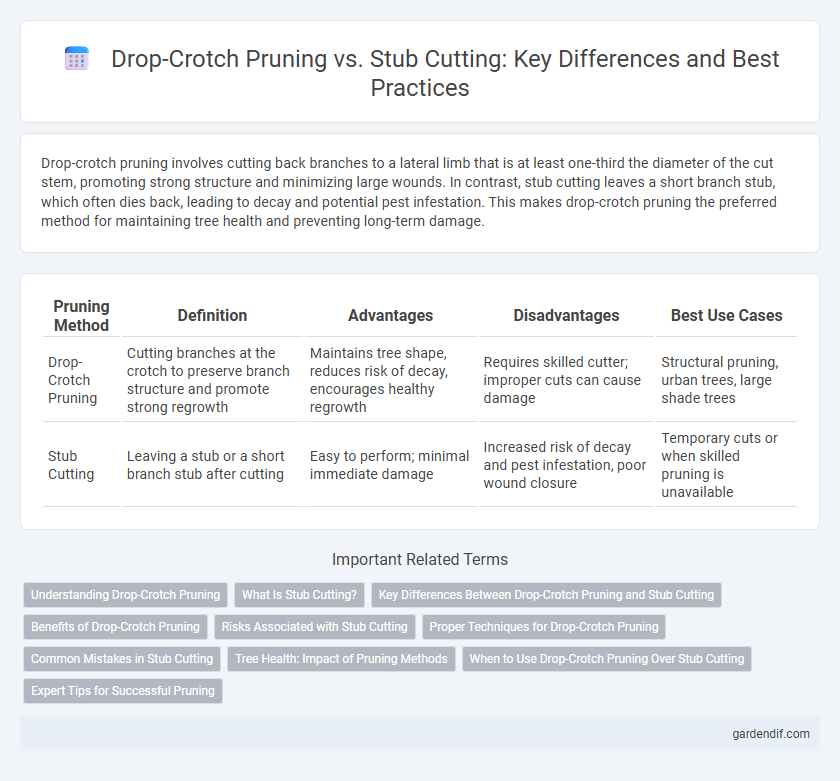
Drop-crotch pruning vs stub cutting Illustration
Drop-crotch pruning involves cutting back branches to a lateral limb that is at least one-third the diameter of the cut stem, promoting strong structure and minimizing large wounds. In contrast, stub cutting leaves a short branch stub, which often dies back, leading to decay and potential pest infestation. This makes drop-crotch pruning the preferred method for maintaining tree health and preventing long-term damage.
Table of Comparison
| Pruning Method | Definition | Advantages | Disadvantages | Best Use Cases |
|---|---|---|---|---|
| Drop-Crotch Pruning | Cutting branches at the crotch to preserve branch structure and promote strong regrowth | Maintains tree shape, reduces risk of decay, encourages healthy regrowth | Requires skilled cutter; improper cuts can cause damage | Structural pruning, urban trees, large shade trees |
| Stub Cutting | Leaving a stub or a short branch stub after cutting | Easy to perform; minimal immediate damage | Increased risk of decay and pest infestation, poor wound closure | Temporary cuts or when skilled pruning is unavailable |
Understanding Drop-Crotch Pruning
Drop-crotch pruning targets selective branch removal near the tree crotch to encourage strong, outward growth and minimize weak attachments, enhancing long-term structural integrity. This method reduces the risk of bark inclusion by redirecting growth away from narrow angles that commonly form weak crotches. Compared to stub cutting, drop-crotch pruning promotes healthier wound closure and reduces decay by avoiding large, flush cuts that can invite disease.
What Is Stub Cutting?
Stub cutting is a pruning technique where a branch is cut leaving a short length of stem, or "stub," attached to the main trunk or parent branch. This method often leads to decay and weakly attached new growth, increasing the risk of branch failure and tree health issues. In contrast to drop-crotch pruning, which makes cuts at strong branch junctions, stub cutting leaves unsound attachment points prone to fungal infection and structural weakness.
Key Differences Between Drop-Crotch Pruning and Stub Cutting
Drop-crotch pruning involves making angled cuts at the base of a branch to encourage natural healing, while stub cutting leaves a portion of the branch, often causing decay and poor regrowth. The key difference lies in the cut placement: drop-crotch pruning targets the branch collar to minimize damage, whereas stub cutting ignores the collar, increasing the risk of disease. Effective drop-crotch pruning promotes healthier tree structure and longevity compared to the detrimental effects commonly associated with stub cuts.
Benefits of Drop-Crotch Pruning
Drop-crotch pruning enhances tree structure by reducing the need for large cuts that can stress the tree, promoting faster wound closure and minimizing disease risk. This method encourages stronger branch growth and better weight distribution, resulting in improved tree stability and longevity. By maintaining natural branch angles, drop-crotch pruning also optimizes sunlight penetration and air circulation, fostering overall tree health.
Risks Associated with Stub Cutting
Stub cutting poses significant risks such as increased vulnerability to decay and disease due to the retention of dead tissue. This method can also hamper proper wound healing, leading to structural weaknesses and potential branch failure. Drop-crotch pruning minimizes these hazards by promoting natural branch collar growth and reducing the chance of infection.
Proper Techniques for Drop-Crotch Pruning
Proper techniques for drop-crotch pruning involve making cuts at the collar area of a branch to promote natural healing and reduce bark tearing. This method requires identifying the branch collar and angling the cut just outside it to maintain the tree's structural integrity and prevent decay. Unlike stub cutting, drop-crotch pruning preserves the tree's shape and encourages strong regrowth while minimizing stress on the branches.
Common Mistakes in Stub Cutting
Common mistakes in stub cutting include leaving excessively long stubs that prevent proper wound closure and increase vulnerability to pests and diseases. Incorrect angle cuts can cause water to accumulate, promoting rot and decay in the remaining branch. These errors often result in weak branch regrowth compared to the more controlled structure achieved with drop-crotch pruning.
Tree Health: Impact of Pruning Methods
Drop-crotch pruning preserves tree health by maintaining structural integrity and promoting natural growth patterns, reducing the risk of large wounds that can lead to decay. Stub cutting creates large, unhealed wounds that expose trees to pathogens and pests, compromising vascular tissue and increasing the likelihood of disease. Proper pruning techniques, such as drop-crotch, enhance longevity by facilitating quicker wound closure and maintaining optimal nutrient flow within the tree.
When to Use Drop-Crotch Pruning Over Stub Cutting
Drop-crotch pruning is preferable when controlling tree size while maintaining natural branch structure, especially in fruit trees and large shade trees prone to heavy limb growth. It promotes healthier regrowth by reducing branch weight and preventing oversized stub formation that can lead to decay and weak attachment. Use drop-crotch pruning to encourage strong lateral branches and minimize long-term damage compared to stub cutting, which is better suited for removing infected or structurally compromised limbs.
Expert Tips for Successful Pruning
Drop-crotch pruning encourages natural branch development by cutting back to a lateral bud or branch that is at least one-third the diameter of the parent branch, promoting structural integrity and minimizing weak growth. Stub cutting, which leaves a short branch stub, often leads to decay and weak regrowth, increasing the risk of disease and structural failure. Expert pruning emphasizes precise cuts at branch collars and recommends avoiding stub cuts to enhance tree health, longevity, and aesthetics.
Drop-crotch pruning vs stub cutting Infographic

 gardendif.com
gardendif.com